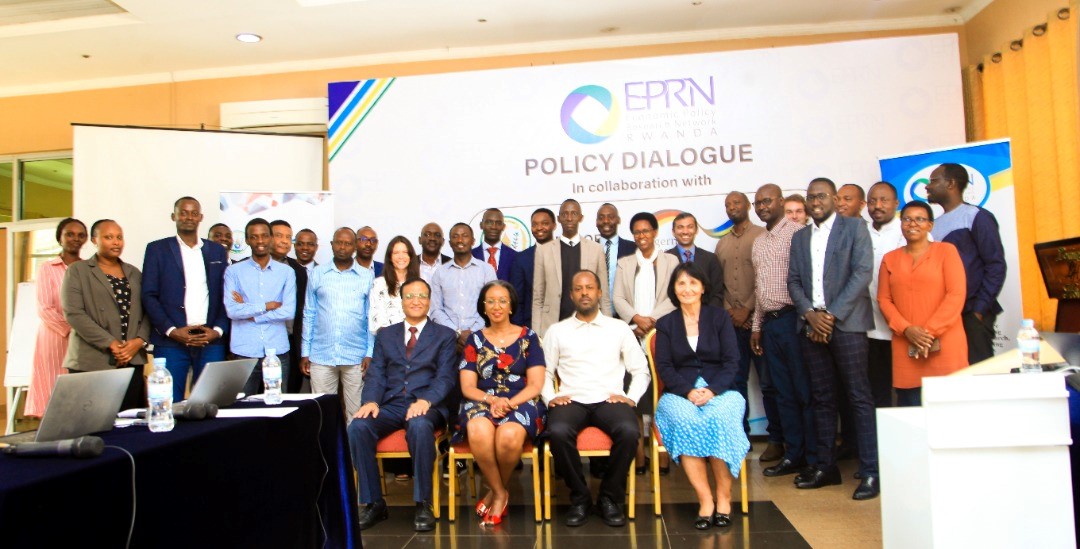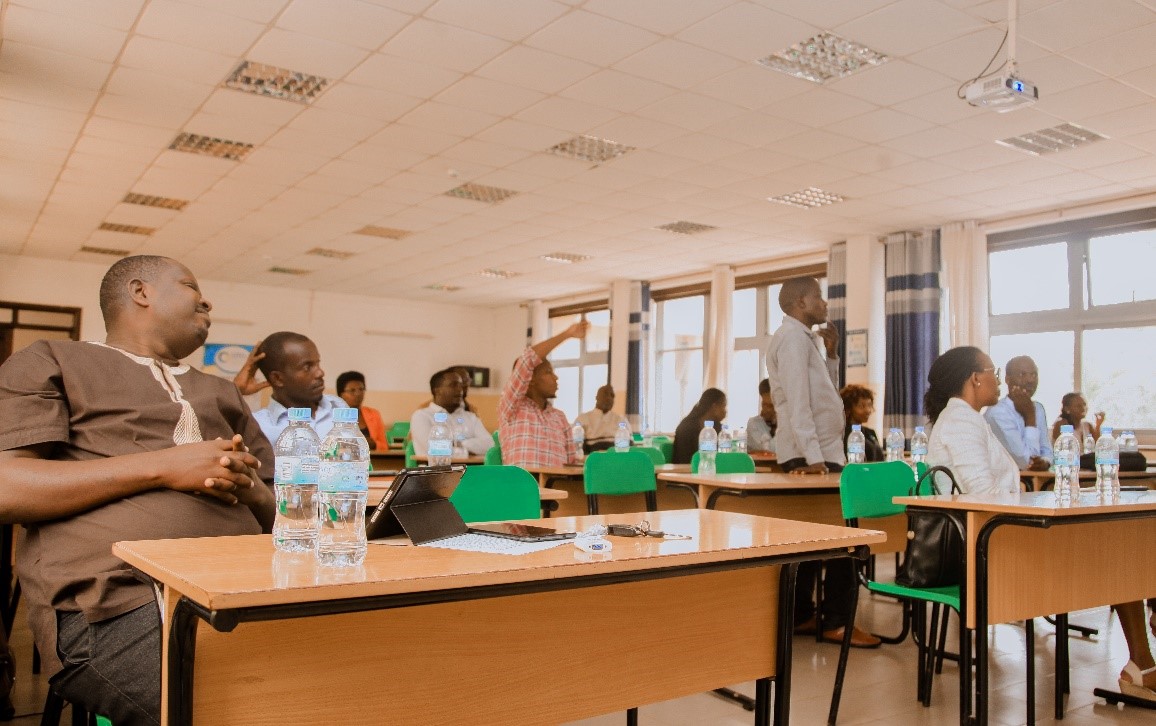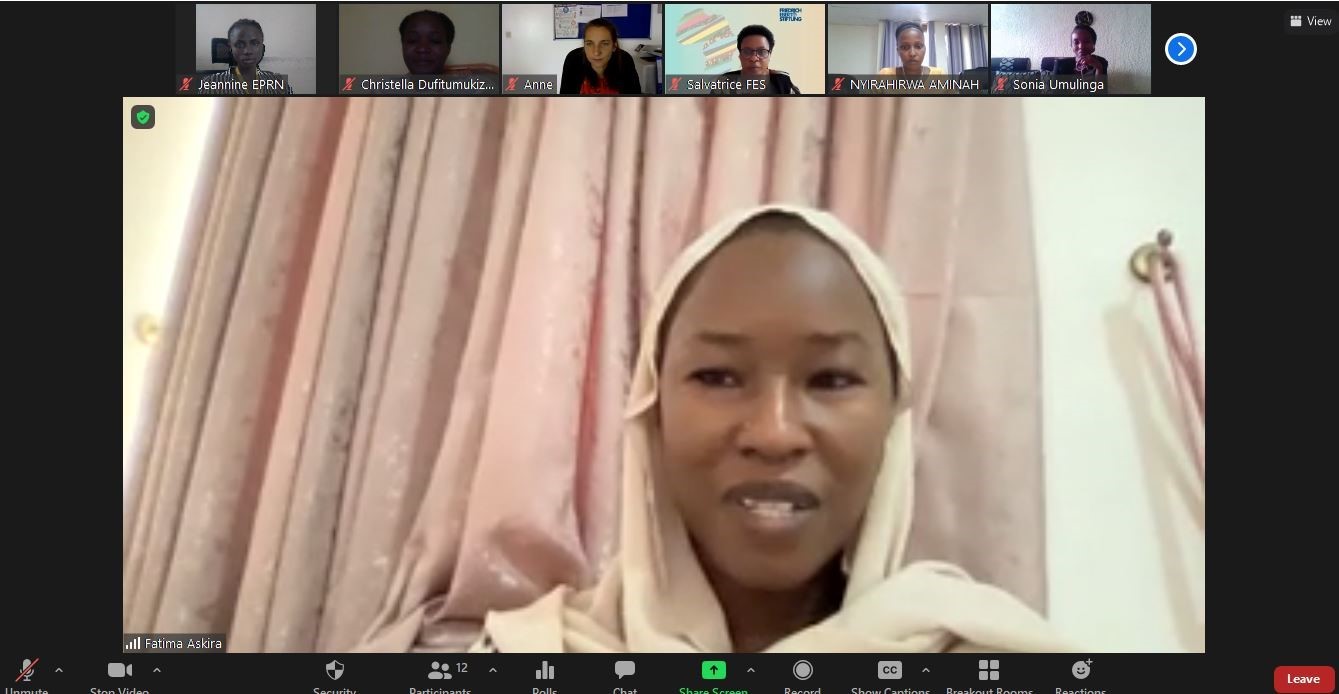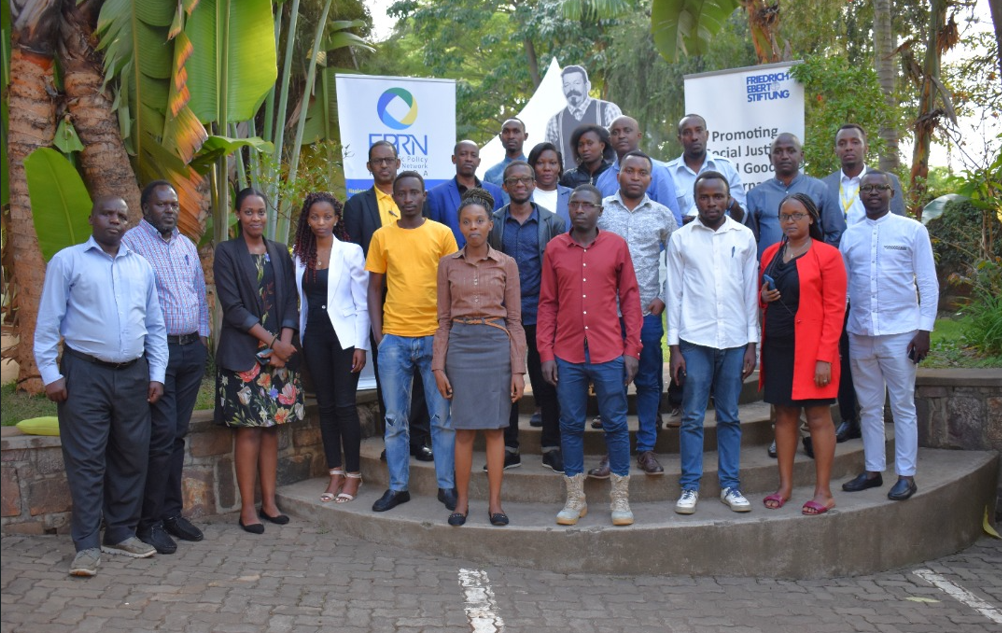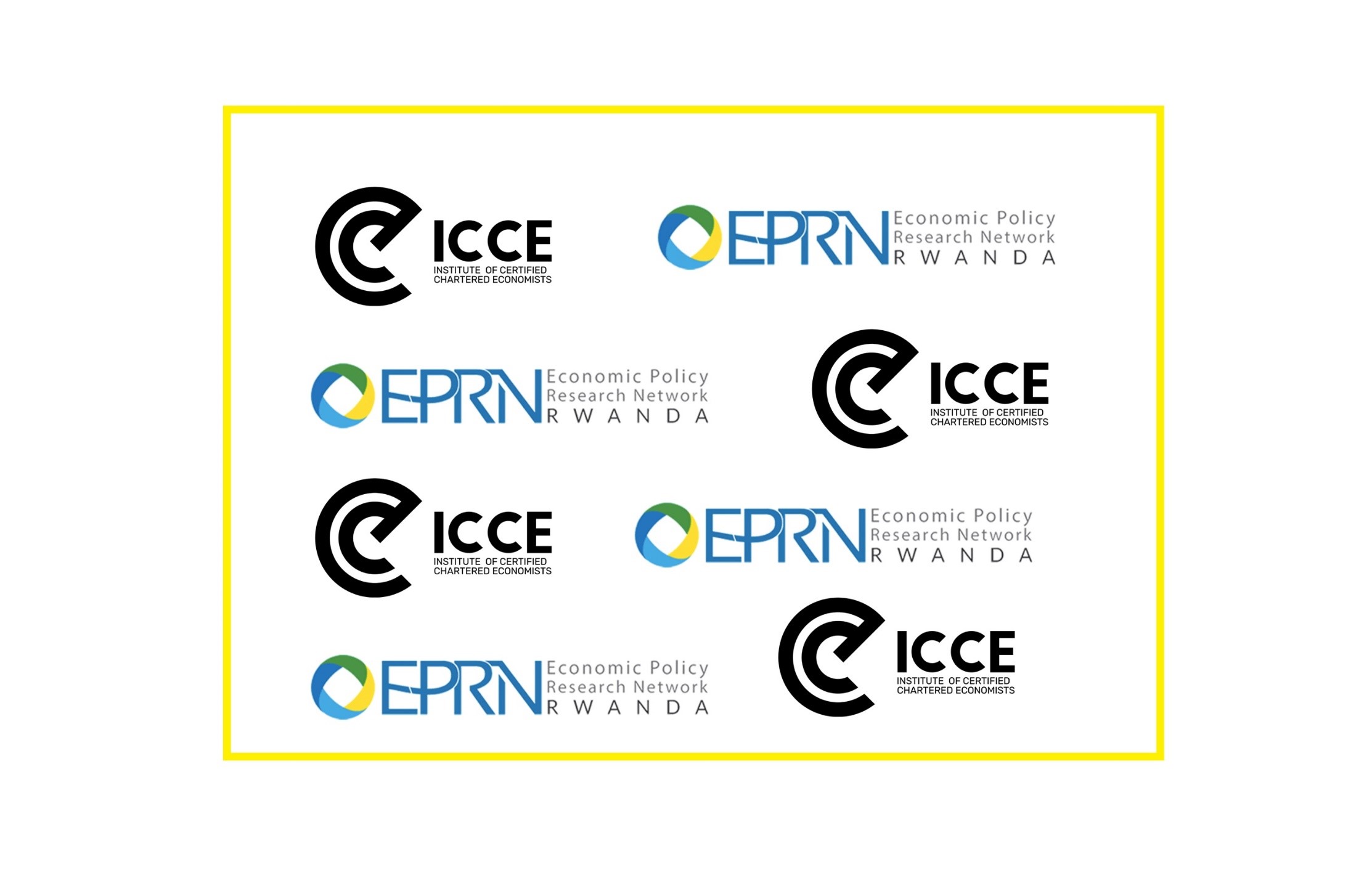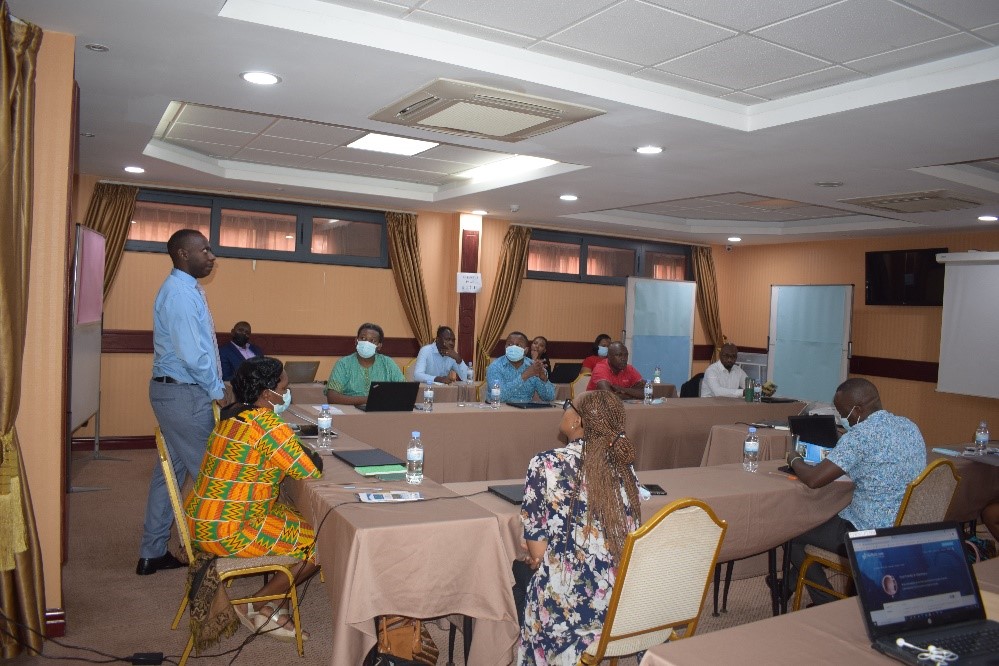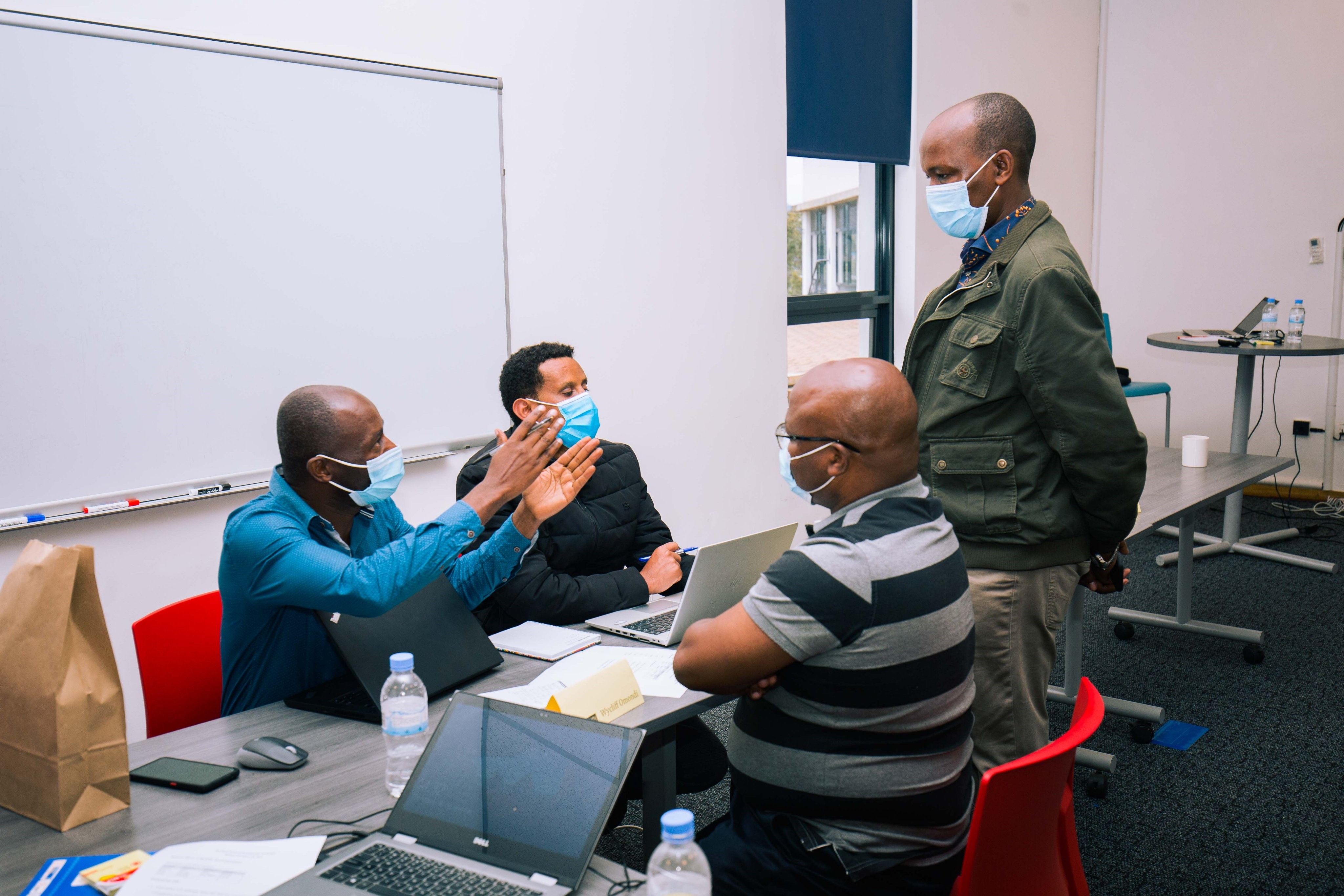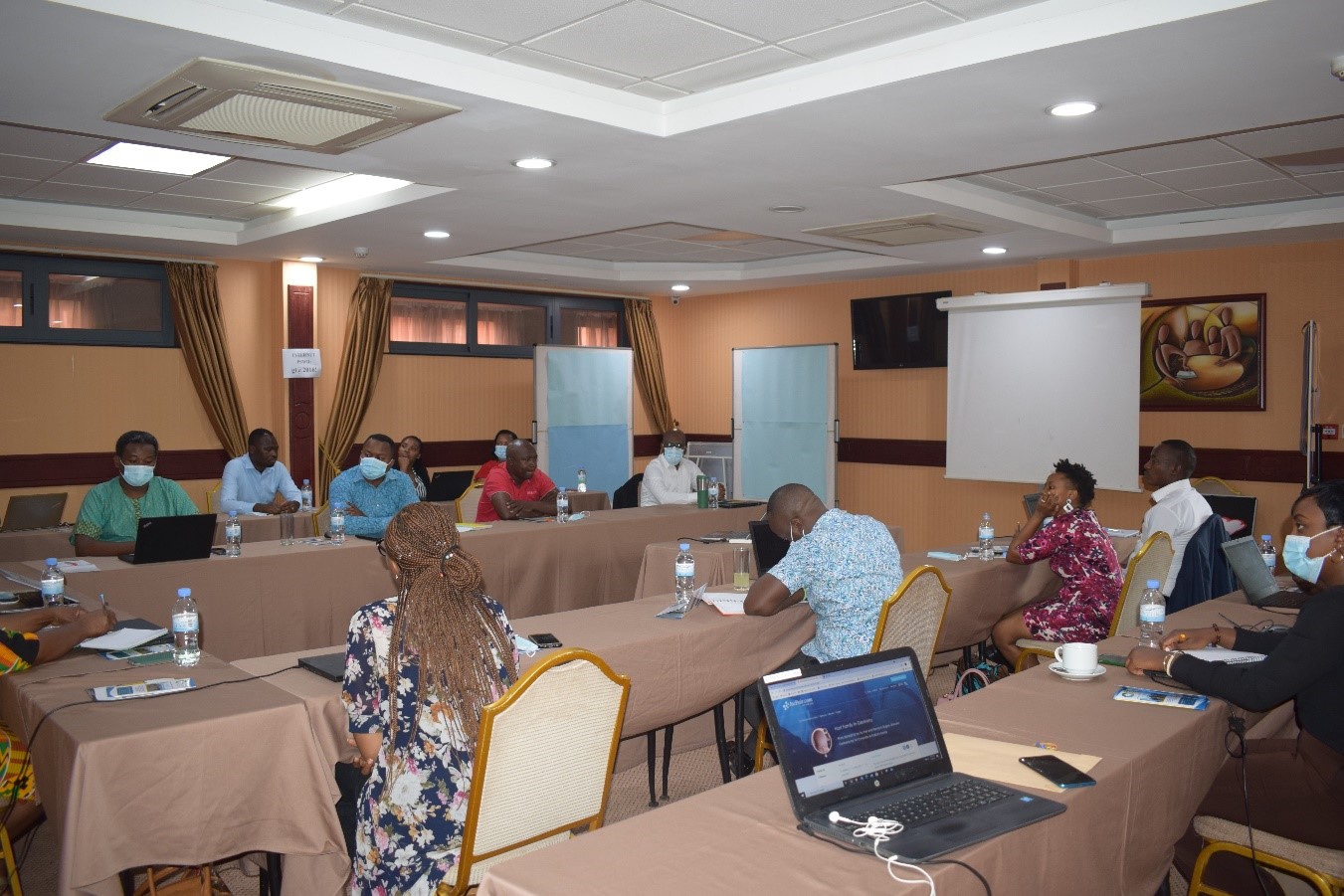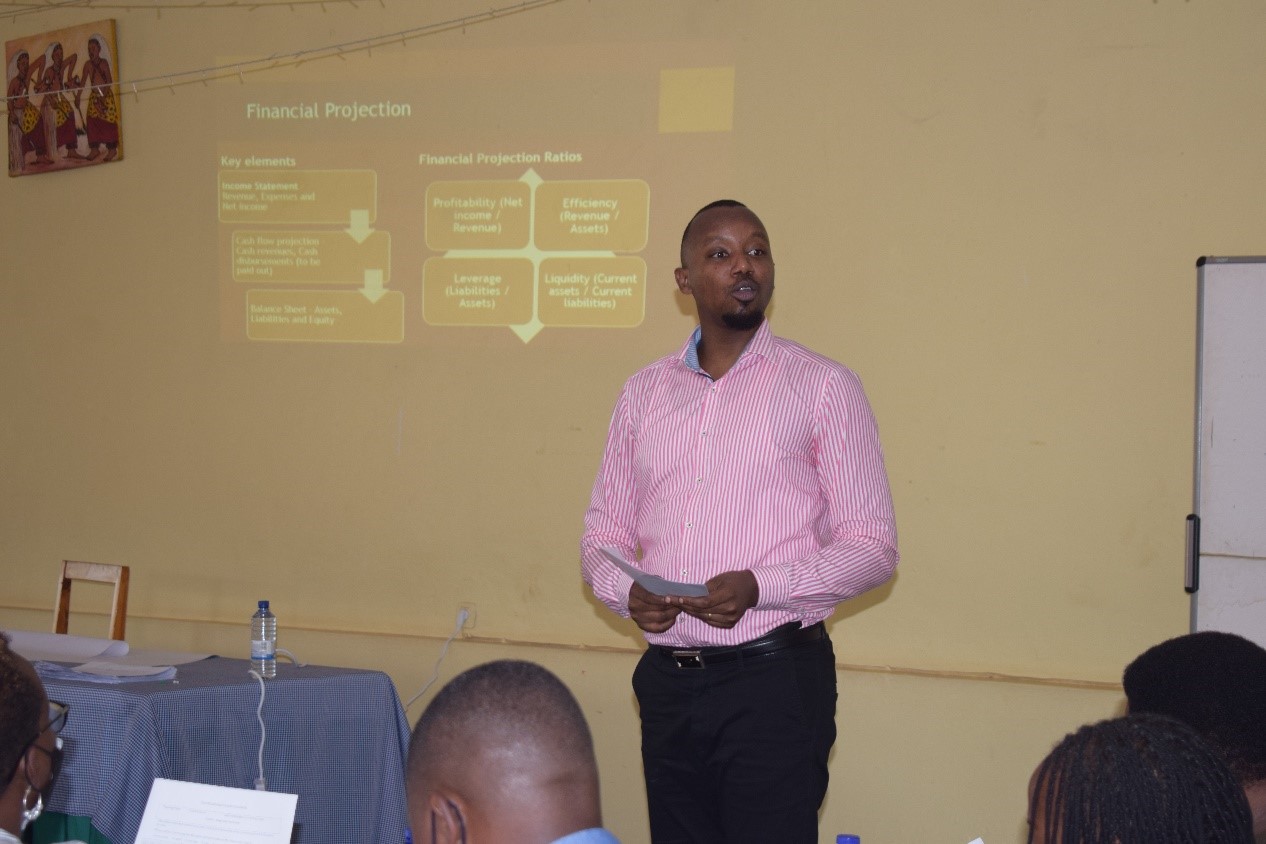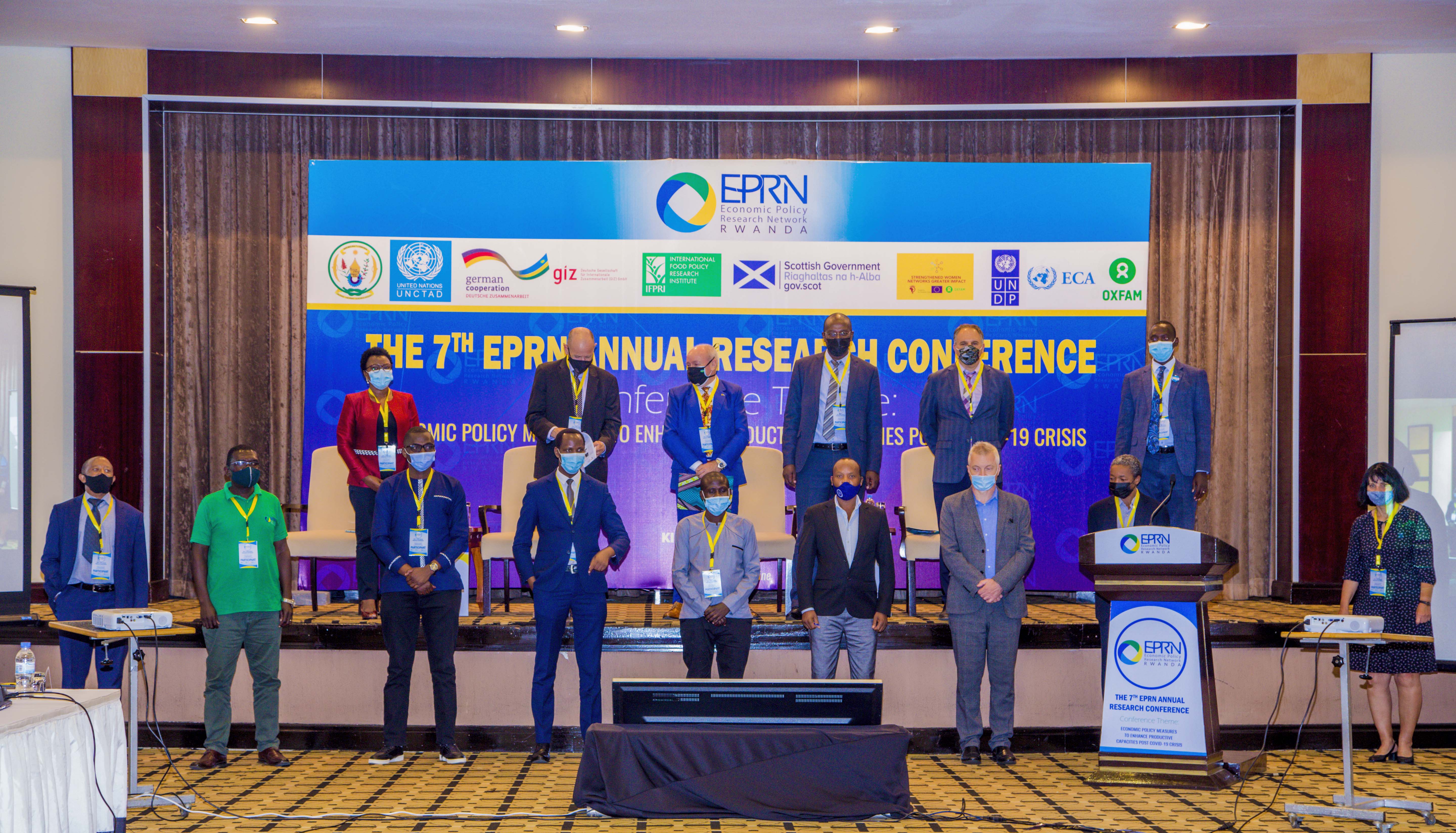Fourth EPRN Reserach Conference 2018
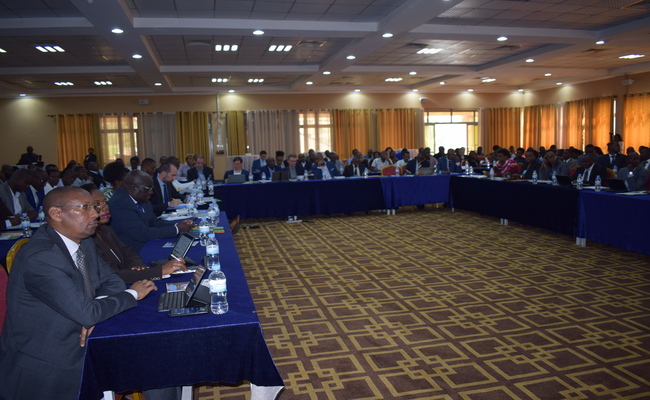
Jointly organized by : EPRN,GIZ and Central Bank of Rwanda
January 31, 2018 @ Lemigo Hotel-Kigali
1. Introduction
For the fourth time now, EPRN with support from the Germany Cooperation (GIZ) and in collaboration with the National Bank of Rwanda (BNR) organized the annual research conference to disseminate research findings from its scholars and those from other research and academic institutions. The theme for the conference was “Growth trajectories, the relevance of home-made solutions and regional integration” and it was held on January 31, 2018, at Lemigo Hotel-Kigali.
The conference gathered more than 250 researchers, policymakers, academicians, development partners, and civil society organizations.
2. Opening Remarks
In his welcome remarks, the Legal Representative of EPRN, Dr. Chares Ruhara thanked all participants for having responded positively to the invitation. He reminded me that the purpose of EPRN annual conferences is to share research findings and formulate recommendations to inform policymaking. He also thanked BNR for their interest in partnering with EPRN to organize this conference. Research from BNR experts added value to the conference content and helped to attract a wider audience.
On the other side, in his opening remarks, the Governor of the Central Bank of Rwanda, Mr. John Rwangombwa, thanked EPRN for this initiative of annual research conferences. He also congratulated all researchers who carried out research and ready ta make presentations.
3. Conference proceedings
The Conference focused on how economic policy researchers can provide Rwanda with home-grown analysis and solutions to real-world problems. In total ten research papers were presented around monetary policy, VUP Program, agriculture productivity, interest rates, regional integration…
The presentations were followed by discussions and panelists providing their perspectives to trigger the exchanges of viewpoints among economics experts, researchers, and policy analysts, either with prepared topics or in response to questions from the audience.
Presented papers :
a. Determinants of Interest Rate Spread in Rwanda (By Mr. Karangwa Mathias and Mr. Nyalihama Christian) :
This paper builds on Kigabo et al. (2007) and Karangwa et al. (2014) to update empirical analysis of the determinants of the interest rate spread, in addition to examining the determinants of the deposit rate and the lending rate in Rwanda. Using data for 2006q1-2017q1, random, and fixed-effects models for the deposit rate and lending rate is estimated. The paper notes that the deposit rate has been more volatile than the lending rate mainly because the deposits market is driven by large depositors who have negotiating power and also due to the emergence of other investment opportunities, such as the treasury bills. The deposit rates are also more responsive to economic activities given that the latter affects the balance sheets of depositors. However, the deposit rate has a small effect on the lending rate, thus operating cost, loans’ market concentration, and loan loss provisions are identified as causes of the rigidity in the lending rate. Finally, the study estimates the GMM model for the interest rate spread and identifies operating cost, credit risk (loan loss provisions), market power in the loans market, and the treasury bills rate as the main drivers of interest rate spread in Rwanda. Policy recommendations from this study include the need to continue facilitating competition among banks, monitoring domestic government borrowing, embracing new cost-minimization technologies, and putting in place measures to reduce credit risk. These measures may include : ensuring macroeconomic stability and effective communication to positively influence expectations and reduce risk perceptions, and, improving capacity to assess loan applications and loan management.
b. Determinants of Non-Performing Loans (NPLs) in Rwanda (By Mr. Karuhanga K. Wilson, Mr. MANIRAGUHA Faustin and Mr. HAKUZIMANA Alfred)
The study aimed at examining macroeconomic, banks specific, and borrowers’ specific determinants of nonperforming loans in the Rwandan banking sector. To investigate these effects, the study involved both quantitative and qualitative approaches. The first approach applied econometric model estimation that looked at both bank-level and macroeconomic indicators over the period 2012Q1-2017Q2. On one part, the covariates we estimated include real GDP growth, inflation, and exchange rate depreciation for general macroeconomic conditions, while return on assets, real interest rate, growth of loans, and bank size as bank-specific factors. On the other hand, the NPLs ratio was taken as the dependent variable. The second fold of the analysis encompasses the survey approach on both banks and big borrowers experienced repayment difficulties to identify specific causes of loan defaults that may not be captured by econometric estimations. The reason for applying these approaches concurrently was to examine these determinants at all possible levels based on providing information viable for the NBR formulation of monetary policy decisions.
Applying fixed effect panel model estimation, the findings obtained are in line with results found by numerous existing studies. For bank-specific variables, bank size, return on assets, and growth of loans is found negatively influencing the level of NPLs, while the real interest rate is significantly and positively contributing to poor bank asset quality. For macroeconomic indicators ; real economic growth, inflation, and exchange rate stand-out to be the main drivers of NPLs, pointing out that higher real GDP growth increases the real income of borrowers, unlike inflation and exchange rate depreciation that adversely affect borrowers businesses. Previous NPLs estimation is also found as a basis of the existing level of loan defaults. Concerning bank survey results, the findings showed that delays in payment of public works, climate change, low occupancy rate, government reforms, loan diversion, and insufficient working capital as key factors determining the occurrence of NPLs. On the other hand, the results from borrowers perspective across sectors indicated that banks behavior towards borrowers, lack of credit terms negotiations, financial constraint due to the inadequacy of loans released, low occupancy rate, the inadequacy of grace period and loan repayment schedules, high lending interest rate, unawareness of credit terms as commonly shared factors ascribed to cause NPLs across respondents from all the surveyed sectors.
To improve the loan quality, the study recommends banks extend their scope of macroeconomic surveillance to include prudential indicators such as profitability of the real economy, improve operational efficiency to reduce the cost of borrowing as well as loan education to borrowers among others. Borrowers have required to authentically carry out project appraisals as well as be equipped with financial literacy before opting to contract with the banks. Finally, NBR to enforce supervisory roles on banks, while amplifying public financial literacy campaigns.
c. Financial Intermediation and Economic Growth : Evidence from Rwanda (By Sebuhuzu Gisanabagabo)
The relationship between financial intermediation and economic growth has been under investigation for decades. Some studies have been conducted using panels of countries with or without similar characteristics while others have been carried out on individual countries. In less-developed countries, the evidence about the link between financial intermediation and economic growth is particularly deficient. This study attempts to empirically investigate the possible cointegration and causal link between financial intermediation and economic growth in Rwanda, using quarterly data spanning from 1996Q1 to 2010Q4. A Structural Vector Autoregressive model is used to analyze the short-run dynamics between variables of interest. Findings of the study show evidence of a cointegrating relationship between financial intermediation and economic growth in the country. It is further observed that a shock to domestic private sector credit accounts for the largest proportion of fluctuations in real output growth, while the shock to potential liquidity comes second. This supports the supply-leading hypothesis in the intermediation link between financial sector development and economic growth in Rwanda, which suggests that the country can achieve significant economic growth if it reinforces incentives to attract businesses that can easily make use of the present financial services.
d. The East African Community Monetary Union : Ready or Not ? (By Dr Charles Ruranga and Prof Thomas Kigabo)
This paper investigates the readiness of the East African Community (EAC) country members for a monetary union. A bivariate vector-autoregressive (VAR) model using the log of real GDP and inflation has been used. Analysis of correlations of demand shocks and correlations of supply shocks have been done and results demonstrated that correlations of demand shocks are not statistically significant while correlations of supply shocks are statistically significant between Kenya and the rest of the countries and between Rwanda and Burundi as well as between Rwanda and Tanzania. This implies that there are greater problems for a monetary union related to significant supply shocks while for demand shocks there is no problem because demand shocks can be expected to become more similar with monetary policy, while supply shocks cannot. Based on these findings we can conclude that at this stage all EAC countries can’t form a monetary union and we recommend working on differences before the creation of the monetary union.
e. Rwanda’s Agricultural Productivity Gaps (By Paul Brimble, MINEOFIN/ODI)
This paper explores how productivity in Rwanda’s agricultural sector has changed over time. In the majority of countries, there exists an agricultural productivity gap where the value-added per worker is much higher in the nonagricultural sector than in the agricultural sector. During the 1990s, Rwanda’s agricultural productivity gap was incredibly high but during the early 2000s, the agricultural productivity gap experienced large declines before stagnating from 2005 onwards. For this new period between 2005 and 2014, improved measures of value-added and labor inputs show that significant differences in hours worked and human capital per worker across sectors can explain a sizeable proportion of the agricultural productivity gap. Even after these adjustments, there remains a persistent agricultural productivity gap of approximately 50%. This result implies that there may be significant welfare gains for agricultural workers who change sectors and increase their average incomes, leading to a reduction in poverty.
f. Second round effect of food and energy prices to inflation in Rwanda (By Mr. MANISHIMWE Christian)
There is a wide consensus in the economic literature that the central bank should not react to changes in food and energy prices as these prices are assumed to reverse quickly. However, some concerns ignore food and energy inflation may lead to misguided monetary policy decisions mainly in economies with higher shares of food and energy items in the consumer basket.
Monetary policy reaction to the shocks in food and energy prices would depend however on whether or not there exists a second-round effect from these shocks. Using the gap-model, we looked at how fresh food and fuel prices impact inflation in Rwanda, found the existence of second-round effects resulting from fresh food price shocks but with very low magnitude. The central bank is advised to not ignore the second-round effect in monetary policymaking and apply communication strategies to mitigate the second-round effect and arising inflation expectations. Besides, fiscal policy should be supportive through enhanced domestic food production policies and incentives to improve the supply of food.
g. Poverty alleviation in Rwanda : the impact of the vision 2020 Umurenge Program (By Dr Thierry Mihigo)
The Vision 2020 Umurenge Program (VUP) is Rwanda’s flagship anti-poverty program and has been implemented since 2008 with the number of VUP support sectors increasing each year. This paper attempts to empirically evaluate the impact of VUP on poverty alleviation through multiple econometric techniques at the household level using panel data from household surveys EICV 3 and EICV 4 as well as a VUP specific sample of EICV4. Analysis of panel data focuses on explaining the impact of VUP participation and other demographic characteristics on Households’ poverty level using random effect ordered probit estimation. Using the VUP sample of EICV 4, the analysis shows the average difference in consumption due to the VUP participation using matching estimations. One of the main results obtained by using control and treatment groups is that participating in VUP significantly increases consumption for the first year of participation, but after that, the consumption is quite stable. By analyzing the results using both datasets, this paper aims to provide a comprehensive evaluation of the VUP.
h. Effect of International Remittances on Poverty in Rwanda (By KADOZI Edward)
International remittances to developing countries have been increasing in recent decades and they constitute a critical lifeline for millions of recipient households. However, there is a growing mixed empirical claim about their impact on socio-welfare in recipient economies. In the case of SSA countries, a sparse empirical study is providing an in-depth understanding through which these inflows reduce poverty and improve development outcomes. This paper contributes to this scholarship by examining the micro-impact of remittances in Rwanda. Specifically, how international remittances affect consumption expenditure per adult equivalent of recipient households, and how they contribute to the development outcomes. I employ both ordinary least square and propensity score matching techniques to address the latter objective. The OLS results suggest that international remittances increase consumption expenditure per adult equivalent of recipient-households between 39.3% and 46.3% more than non-remittance recipient households. The PSM results reveal that, on average, international remittances affect the poverty of recipient households by 54.7% significantly higher than non- recipients. Similar findings indicate that households receiving international remittances spend on average, 5.16%, and 4.83% on physical investment respectively more than non-recipient households.
While similar remittance-recipient households on average, spend respectively 6.99%, 107%, 24.9%, and 16.1% statistically significantly more than non-recipients on business, savings, education, and health in Rwanda. The findings suggest that the government should harness formal remittance inflows by introducing mechanisms through which international remittances could be channeled into savings, investments, and socio-economic activities that spur socio-economic development in the country.
i. Population growth control in Rwanda : Closing the Poor-Rich Gap in Contraceptive Use in Rwanda (By Dr Dieudonne Ndaruhuye Muhoza)
Rwanda has made an impressive increase in population growth control during the last decade. The Contraceptive Prevalence Rate (CPR) rose threefold from 17% in 2005 to 52% in 2010 and 53% in 2014. Contraceptive uptake was recorded more among poor populations than among the rich and rural than among urban residents. As a result, the poor-rich gap in family planning evolved in convergence.
This paper investigates the pathways through which the narrowing contraceptive gap is occurring. More specifically, the research examines the extent to which the differences in trends are associated with the differences in demand for children and/or the differences in family planning services in terms of types of contraceptive methods used and sources of supply. Understanding these mechanisms is essential for both family planning providers and policymakers in Rwanda to evaluate the ongoing program and take the best way towards a sustainable population growth control. It is also useful for other countries to improve their family planning programs. The study uses a polled dataset from 2005, 2010, and 2014 DHS datasets. Descriptive statistics and Multivariate analysis are used to describe the trends and assess the change of overtime.
Results indicate that the convergence in contraceptive use is associated with a higher decline in desired fertility and higher uptake of long-acting methods among the poor. The Community Health Worker service would have played an important role in the uptake among the poor population.
The study suggests that the increase in contraceptive use among the poor requires specific strategies following the local culture, a strategy that will respond to their requests and aspirations.
j. The impact of financial Education through Savings and Credit Cooperatives in Rwanda (By Innovations for Poverty Actions)
Limited financial knowledge, skills, and confidence are associated with suboptimal financial behavior such as low rates of formal savings, limited usage of deposit and transactional accounts, and over-indebtedness. The Government of Rwanda, World Bank, and Innovations for Poverty Action (IPA) partnered to evaluate the impact of financial education delivered through Savings and Credit Cooperatives (SACCOs) on members’ financial knowledge, skills, attitudes, behavior.
Preliminary Results
The results of the randomized evaluation find that members of Group 1 SACCOs report better outcomes as compared to comparison group SACCO members, including concerning setting financial goals, budgeting, and saving. Since Group 1 SACCOs had more freedom to choose who led the implementation of the program at their SACCO, the results indicate that that greater operational autonomy at the SACCO level can result in a more effective provision of financial education. Specifically ;
• Providing financial education to members of SACCOs, and giving the SACCOs more operational autonomy to implement the program, made members more knowledgeable of key financial rules of thumb.
• Members in this group were more likely to report financial attitudes that emphasize saving and responsible borrowing, and to report having - and strictly adhering to - a written budget and financial plan.
• They were also more likely to report saving regularly towards financial goals.
• However, no impacts were found on account usage, borrowing behavior, or financial security, highlighting the challenge of translating changes in knowledge and attitudes into behavioral change.
4. Recommendations from conference
After presentations and discussions by participants, the following policy recommendations were drawn up :
a. There is a need to continue facilitating competition among banks, monitoring domestic government borrowing, embracing new cost-minimization technologies, and putting in place measures to reduce credit risk. These measures may include : ensuring macroeconomic stability and effective communication to positively influence expectations and reduce risk perceptions, and, improving capacity to assess loan applications and loan management.
b. To improve the loan quality, banks should extend their scope of macroeconomic surveillance to include prudential indicators such as profitability of the real economy, improve operational efficiency to reduce the cost of borrowing as well as loan education to borrowers among others. Borrowers have required to authentically carry out project appraisals as well as be equipped with financial literacy before opting to contract with the banks.
c. BNR to enforce supervisory roles on banks, while amplifying public financial literacy campaigns.
d. So far EAC Countries are not in a position to form a monetary union and Member States should focus on working on differences before the creation of the monetary union.
e. BNR is advised to not ignore the second-round effect in monetary policymaking and apply communication strategies to mitigate the second-round effect and arising inflation expectations.
f. Fiscal policy should be supportive through enhanced domestic food production policies and incentives to improve the supply of food.
g. The Government should harness formal remittance inflows by introducing mechanisms through which international remittances could be channeled into savings, investments, and socio-economic activities that spur socio-economic development in the country.
5. Conclusion
Closing remarks were given by the Deputy Governor of the Rwanda National Bank, Ms. Monique Nsanzabaganwa. She started with a note of thanks to EPRN and the researchers for the rich and diverse scope of papers presented and encouraged EPRN to keep organizing such research sessions including policy dialogues around emerging topics of socio-economic growth of our country and at a global glance.
Female participation is also still low (31%) and out of 10 papers presented none from a female researcher. Incentives need to put in place.





